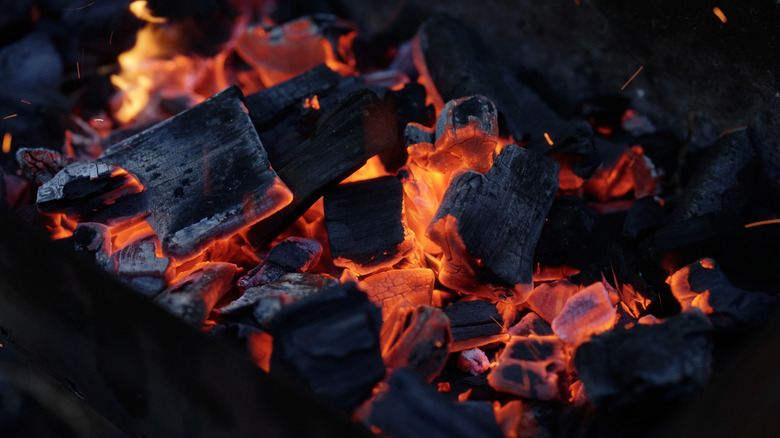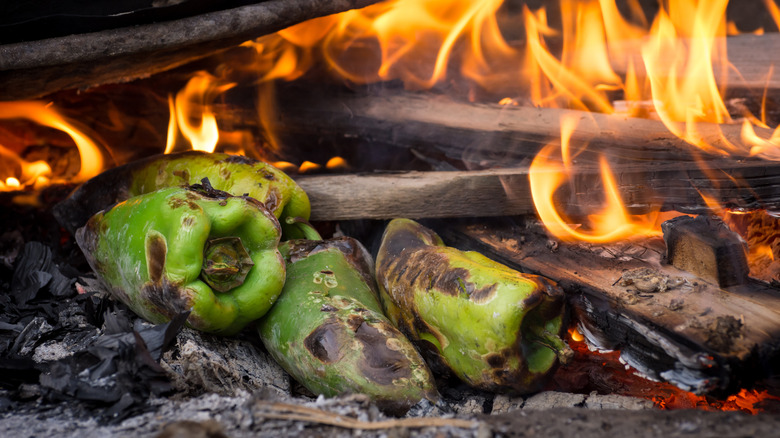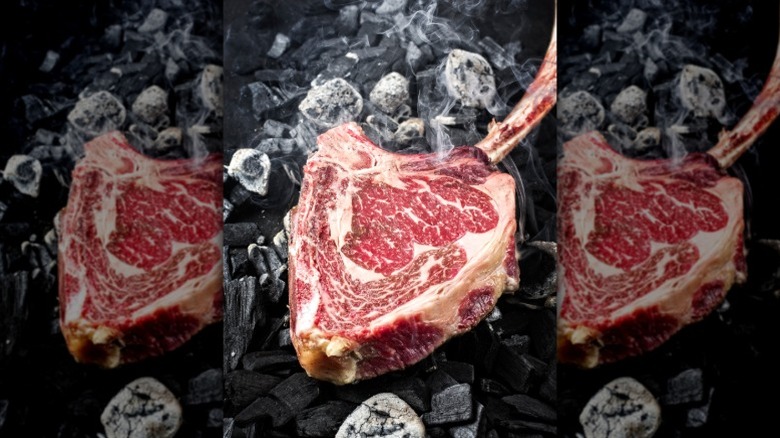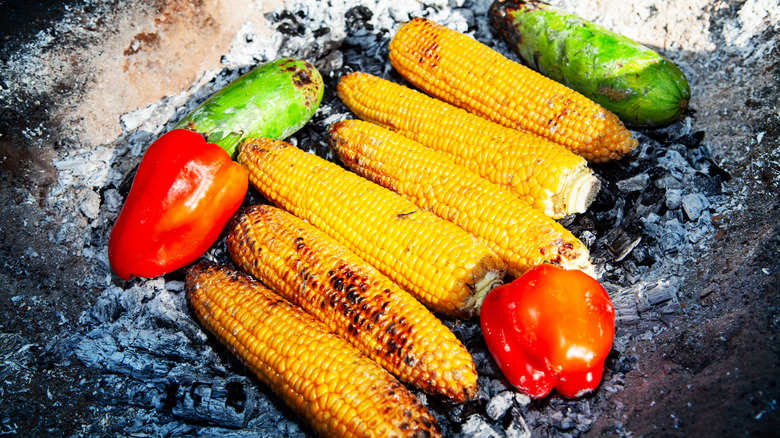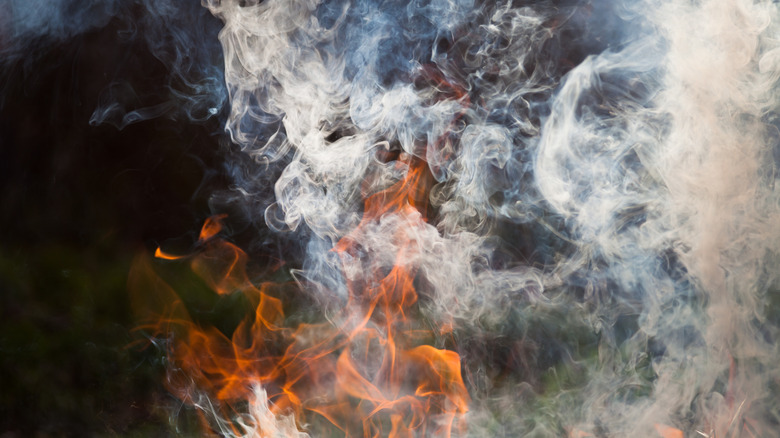The Savvy Way To Roast Food When Your Grill Grates Are Too Full To Use
Cooking for a crowd is tough — especially when you run out of space on the grill. One solution? Cook your food right on the coals. While it might sound scary, the technique (known as dirty grilling) is a time-honored way to get a perfect sear. Admittedly, dirty grilling is aptly named. It isn't for the nervous, and yes, you might get a little ash on your steak. Still, the method is cleaner than you'd expect — and, at the very least, it's a fun thing to try.
Grillmaster Christie Vanover gave The Takeout some tips. Vanover, who started grilling competitively in 2012, currently runs Girls Can Grill. She's competed on Food Network's "BBQ Brawl," competed at the World Food Championships, and partnered with a long list of leading cookware brands. She also shares tips on her Instagram and hosts the podcast BBQ Tips.
Vanover is a big proponent of teaching everyone to grill, but she admits that dirty grilling takes skill. "Cooking food directly on the coals can be a bit tricky because the heat is so intense," she says. She's not kidding: Those coals can reach temperatures of 800 to 1,000 degrees Fahrenheit. Despite the high heat, your steak (probably) won't burn to a crisp, though. Since there isn't much oxygen directly above the coals, you're actually less likely to burn the beef. That doesn't mean that dirty grilling is easy, but with a few tips and tricks you can cook a stellar steak.
What can you cook on the coals?
"There are two main methods," says Vanover. "You can sear meats directly on the coals or you can bury food, usually vegetables, in hot ash." There's a reason why Vanover recommends sticking to veggies for the second method. Bury a rib roast, and you'll get a mouth full of ashes. But vegetables? Just keep a peeler on hand. "[Ash] is fine for vegetables that get peeled, like squash or onions."
Pay close attention to the coals if you want to avoid accidental ash. "The amount of ash that will stick to your food depends on the temperature and composition of the coals," Vanover continued. "If they still have integrity, they will sear your food like a hot plate. If however, they have already started to break down into ashes, you will get some ash on your food." Don't lose hope if you get a little ash on your meat, though. "If you do get ash on your meat, just brush it or wipe it off."
So, how do you know when your food is done? "With both techniques, the best way to know if your food is done is to use a digital thermometer," she says. Remember to use safety gear like heavy-duty grill mitts. Regular oven mitts can't handle the heat.
How to cook on coals
Cooking on the coals is the oldest method of cooking meat. Admittedly, cavemen didn't have access to top-of-the-line Weber grills — but the method still has its merits many millennia later. One fan from recent history? Former President Dwight D. Eisenhower. Eisenhower, a Texas native, didn't mess around with the grill part of grilling. In 1953, the Miami Daily News reported that the newly-anointed president "rubs the steak with oil and garlic and then, as the horrified guests look on, casually flings the steak into the midst of the red and glowing coals."
Use natural lump charcoal if you plan to try it yourself. Two chimneys will cook enough for a crowd, while one will do for a smaller gathering. As for the meat, Vanover recommends keeping it simple. "Hearty meats like beef or pork steaks work best," she explains. "Limit your seasoning to salt and pepper and place the meat on the coals. It will sear almost immediately."
Three to five minutes per side is enough to get a three-quarter-inch steak to rare; try eight to ten minutes for larger cuts. Just keep your eyes on the prize and your tongs in hand. "As soon as the Maillard reaction happens and the meat forms a crust, it will be time to flip the meat to cook the other side," says Vanover. Don't worry about it sticking. Since the crust forms so quickly, the meat should lift away with ease.
How to cook in ash
"The second method is called rescoldo-style cooking, which is a South American technique," Vanover says. "It works great for vegetables like winter squash or onions. You place the veggies in the ash and shovel more ash on top." Aside from squash and onions, rescoldo-style cooking is also perfect for bell peppers, corn, and potatoes. Don't be afraid to experiment with citrus fruits like lemons. An ash-roasted lemon makes the perfect drizzle for that delectable coal-cooked meat. Still squeamish about all that ash? Wrap the food in aluminum foil first.
Compared to cooking on the coals, rescoldo takes time. While smaller veggies, like carrots or bell peppers, should cook within 15 to 20 minutes; onions, potatoes, and beets will need 45 minutes or more. If necessary, brush some ashes aside to check your progress. "Once they're cooked through, you uncover them, remove the outer layer and enjoy," she says. You don't have to limit yourself to fruits and veggies, though. Chilean cooks place dough directly on the ash to make traditional tortillas. You can even use the method for soups and stews. Just bury a Dutch oven whole and let it simmer for a few hours.
Is it safe to cook directly on coals?
Grilling always comes with a burn risk. And, while your food probably won't go up in flames if you cook on the coals, you're still working with extreme temperatures. Take extra precautions to avoid burns. But what about all that ash? The ash itself won't hurt you — at least, as long as you avoid briquettes. Charcoal briquettes often contain lighter fluid and other nasty chemicals. They're much ashier than natural lump charcoal, too, so it's harder to cook a clean steak. Natural lump charcoal is more eco-friendly and it'll give you a nice, woody, smoky taste. It's Vanover's favorite. On her site she recommends using hardwoods like pecan, hickory, or cherry.
While lump charcoal itself isn't carcinogenic, scientists suspect that grilled food could increase your risk of cancer. According to the National Cancer Institute, cooking meat at high temperatures creates chemicals called Heterocyclic amines (HCAs) and polycyclic aromatic hydrocarbons (PAHs). The Institute states that these chemicals may carry a cancer risk since some studies have linked the chemicals to high rates of cancer in rodents. The higher the temperature, the more HCAs and PAHs — so ultra-high-heat cooking is riskier than low and slow.
Scientists haven't been able to find hard evidence in human studies, though, and the link between red meat and cancer is still up for debate. If you think it's worth the risk, go ahead. Just don't expect perfection: the method isn't fastidious, but it is fun.
